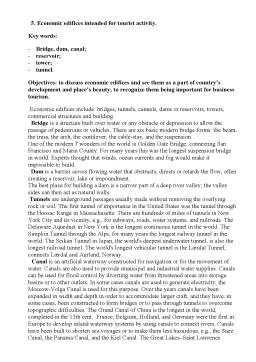Extras din referat
2. Historical edifices.
Key words:
- castle;
- fortification;
- palace;
- citadel.
Objectives: to discuss the most popular types of the group of historical edifices; to highlight significance of them in remote past and present, especially of those developed in tourist activity.
Historical edifices represent constructions of remote past, spread especially in the regions, where great civilizations emerged.
The group of historical edifices contains: Roman castrums, fords; castles, palaces, citadels, fortifications and others.
I consider interesting to discuss some types of the historical edifices.
Castle is a type of fortified dwelling characteristic of the Middle Ages. Fortification of towns had been in practice since antiquity, but in the 9th century feudal lords began to develop the private fortress-residence known as the castle. It served the twofold function of residence and fortress because of the conditions of medieval life, in which war was endemic. The site of the castle was preferably on a defensible height.
Early castles (10th-11th centuries) consisted of a great artificial mound of earth, the motte, surrounded by a dry ditch, or fosse, and surmounted by a wooden blockhouse and its encircling palisade. Until well into the 12th cent., the only English development was the occasional substitution of a massive masonry keep inside the palisade—a form typified in the Tower of London. In the Middle East the Crusaders developed great castles with double circuits of curving outer walls and towers or turrets to overlook all sections of the wall. The form of these castles had an influence throughout the Continent and the British Isles. Thus, early in the 13th cent. the medieval castle, a mixture of Norman, English, and Byzantine elements, reached its full flower, as typified in the Château Gaillard on the Seine in France and in Alnwick and the Conisborough in England.
In general, the castle was planned for security; the living quarters were rude, poorly lighted, and without provisions for comfort. A castle had a military importance.
Fortification is related to branches of the art of military engineering. Fortification deals with the design and construction of defensive structures.
Defense works might be permanent or temporary, it depended political and economical situation Examples of the former are city walls, the castles of the Middle Ages, and the frontier fortresses and harbor defenses of relatively modern times. When a moving situation becomes stabilized, a hastily occupied defensive position may have to be developed into a more strongly fortified position; the classic example of such a development is the stabilization of the western front in Europe during World War I, when trenches and other temporary defense works became permanent fortifications. The primary aim in fortifying a fixed position is to erect a physical barrier.The examples of extensive barriers are the Median Wall between the Tigris and Euphrates rivers in Mesopotamia, the Great Wall of China, or frontier walls built by the Romans against barbarian attack.
Another no less important historical edefice is palace, that is considered (or was) a home of a head of state or other high-ranking public figure. Many palaces have been transformed for other uses, such as parliaments or museums. The most notable and well-known are: Belvedere Palace, Hofburg Palace ,Schönbrunn Palace in Austria, Palais du Louvre, Palais Bourbon, Château de Versailles, Château de Chambord ,Palais des Papes in France,Grand Kremlin Palace,Terem Palace ,Winter Palace ,Tsarskoye Selo (Russia), Vrana Palace (Bulgaria), Xianyang Palace, Taiji Palace, Hall of Supreme Harmony (China), Amalienborg Palace, Frederiksberg Palace in Denmark, also there are noted palaces in Sweden,Spain,USA,UK, Japan, Korea, Malta, Polland, Sweden, Spain, USA, UK.
A citadel is a fortress for protecting a town, sometimes with a castle in its middle.Citadels are most often used to protect a garrison or political power from the inhabitants of the town it is defending. They were designed to ensure loyalty from the town which they defended. Very famous is Dholavira, the Ancient Metropolitan City, locally known as Kotada Timba Prachin Mahanagar Dholavira, that is one of the largest and most prominent archaeological site in India, belonging to the Indus Valley Civilization. It is located on the Khadir island in the the Kutch district of Gujarat.
These elements are the most important of the historical edefices, and the most interesting I consider to discuss. The functions of the edefices changed throught time, but we can make a conclusion that the majority of them served as residence or home of the loyalty and head of state. Another no less imporatant function was to protect the town or the area from enemies. Later some of them transformed in parliments or museums, other containing libraries. In this way historical edefices represent a geat inheritance for our civilization and for those coming. Tourist industry tries to develop the historical edefices so much as possible, because people are in interested in their history and in wonders of the world.
Preview document
Conținut arhivă zip
- Man-made Tourist Resources.doc






















